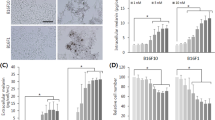Summary
Cell density is a factor that affects the capacity of Cloudman S91 melanoma cells to respond to melanotropins in monolayer culture. Continuous exposure of melanoma cells to α-melanotropin or its potent analog [Nle4,D-Phe7]-α-MSH, resulted in maximal stimulation of tyrosinase after 2 d of treatment, but the magnitude of stimulation decreased thereafter despite the continued presence of the melanotropins. However, when melanoma cells continually exposed to melanotropins were subcultured to an initial low cell density and maintained in contact with α-MSH or [Nle4,D-Phe7]-α-MSH (long-term culture), tyrosinase activity was rapidly restored and greatly enhanced. Also, when cells were seeded at initial densities ranging from 0.2 to 3.2×106 cells/flask, and exposed for 24 h to 10−7 M α-MSH, only the cultures seeded at low densities (0.2 and 0.4×106 cells/flask) exhibited maximal tyrosinase activity during the 24 h exposure to the melanotropins. Therefore, tyrosinase activity was primarily affected by cell density rather than by the duration of time the cells were in culture or by continuous exposure to melanotropin. Other flasks of various cell densities were treated with 10−7 M α-MSH or [Nle4,D-Phe7]-α-MSH for 24 h, followed byremoval of the melanotropins from the culture medium. The magnitude and duration of theresidual stimulation of melanoma tyrosinase activity by melanotropins were also found to be dependent on the initial cell density. These results reveal that there is a limited range of optimal cell densities at which melanoma cells can respond to melanotropins and express increased tyrosinase activity.
Similar content being viewed by others
References
Abdel Malek, Z. A.; Hadley, M. E.; Bregman, M. D., et al. Actions of melanotropins on melanoma cell growth in vitro. JNCI in press; 1985.
Castrucci, A. M. de L.; Hadley, M. E.; Hruby, V. J. Melanotropin bioassays;in vitro andin vivo comparisons. Gen. Comp. Endocrinol. 55:104–111; 1984.
Castrucci, A. M. de L.; Hadley, M. E.; Sawyer, T. K., et al. Enzymological studies of melanotropins. Comp. Biochem. Physiol. 78B:519–524; 1984.
Castrucci, A. M. de L.; Hadley, M. E.; Yorulmazoglu, E. I., et al. Synthesis and studies of superpotent melanotropins resistant to enzyme degradation. Bagnara, J.; Klaus, S. N.; Paul, E., et al., eds. Biological, Molecular and clinical aspects of pigmentation. Pigment Cell 1985. Tokyo: University of Tokyo Press; 1985: 145–151.
Chian, L. T. Y.; Wilgram, G. F. Tyrosinase inhibition: its role in suntanning and in albinism. Science 155:198–200; 1967.
Fuller, B. B.; Viskochil, D. H. The role of RNA and protein synthesis in mediating the action of MSH on mouse melanoma cells. Life Sci. 24:2405–2416; 1979.
Fuller, B. B.; Lebowitz, J. Decay of hormone responsiveness in mouse melanoma cells in cultures as a function of cell density. J. Cell. Physiol. 103:279–287; 1980.
Hadley, M. E. The melanotropins. In: Endocrinology. New Jersey: Prentice-Hall, Inc; 1984:160–178.
Hadley, M. E.; Abdel Malek, Z. A.; Marwan, M. M., et al. [Nle4,D-Phe7]-α-MSH: a superpotent melanotropin that “irreversibly” activates melanoma cell tyrosinase. Endocrin. Res. in press; 1985.
Marwan, M. M.; Abdel Malek, Z. A.; Kreutzfeld, K. L., et al. Stimulation of S91 melanoma tyrosinase activity by superpotent α-melanotropins. Mol. Cell. Endocrinol. 41:171–177; 1985.
Meyskens, F. L.; Thomson, S. P.; Hickie, R. A., et al. Potential biological explanation of stimulation of colony growth in semisolid agar by cytotoxic agents. Br. J. Cancer 48:863–868; 1983.
Oikawa, A.; Nakayasu, M.; Claunch, C., et al. Two types of melanogenesis in monolayer cultures of melanoma cells. Cell Differ. 1:149–155; 1972.
Oikawa, A.; Nakayasu, M.; Nogara, M. Tyrosinase activities of cell-free extracts and living cells of cultured melanoma cells. Dev. Biol. 30:198–205; 1973.
Pawelek, J. Factors regulating growth and pigmentation of melanoma cells. J. Invest. Dermatol. 66:201–209; 1976.
Pawelek, J. M.; Körner, A. M. The biosynthesis of mammalian melanin. Am. Sci. 70:136–145; 1982.
Pomerantz, S. H. The tyrosine hydroxylase activity of mammalian tyrosinase. J. Biol. Chem. 241:161–168; 1966.
Pomerantz, S. H.l-tyrosine-3,5-3H assay for tyrosinase development in skin of new born hamsters. Science 164:838–839; 1969.
Sawyer, T. K.; Sanfilippo, P. J.; Hruby, V. J., et al. 4-Norleucine, 7-d-Phenylalanine α-melanocyte stimulating hormone: a highly potent melanotropin with ultralong biological activity. Proc. Natl. Acad. Sci. USA 77:5754–5758; 1980.
Sawyer, T. K.; Hruby, V. J.; Wilkes, B. C., et al. Comparative biological activity of highly potent active-site analogues of α-melanotropin. J. Med. Chem. 251:1022–1027; 1982.
Sawyer, T. K.; Hruby, V. J.; Hadley, M. E., et al. α-Melanocyte stimulating hormone: chemical nature and mechanism of action. Am. Zool. 23:529–540; 1983.
Thomson, S. P.; Moon, T. E.; Meyskens, F. L., Jr. Kinetics of clonogenic melanoma cell proliferation and the limits on growth within a bilayer agar system. J. Cell. Physiol. 121:114–124; 1984.
Varga, J. M.; DiPasquale, A.; Pawelek, J., et al. Regulation of melanocyte stimulating hormone action at the receptor level: discontinuous binding of hormone to synchronized mouse melanoma cells during the cell cycle. Proc. Natl. Acad. Sci. USA 71:1590–1593; 1974.
Wade, D. R.; Burkart, M. E. The role of adenosine 3′,5′-cyclic monophosphate in the density-dependent regulation of growth and tyrosinase activity of B-16 melanoma cells. J. Cell. Physiol. 94:265–274; 1978.
Wong, G.; Pawelek, J. Control of phenotypic expression of cultured melanoma cells by melanocyte stimulating hormones. Nature 241:213–215; 1973.
Author information
Authors and Affiliations
Rights and permissions
About this article
Cite this article
Abdel Malek, Z.A., Kreutzfeld, K.L., Hadley, M.E. et al. Long-term and residual melanotropin-stimulated tyrosinase activity in S91 melanoma cells is density dependent. In Vitro Cell Dev Biol 22, 75–81 (1986). https://doi.org/10.1007/BF02623536
Received:
Accepted:
Issue Date:
DOI: https://doi.org/10.1007/BF02623536




